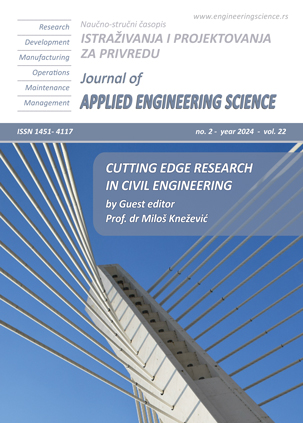IMPACT OF DEVASTATING EARTHQUAKES IN CROATIA IN 2020
Abstract
At the beginning of 2020, the area of Zagreb was hit by an earthquake of magnitude Mw5.4, where a significant number of buildings in the historic core of the city was damaged. Not long after that, at the end of the same year, a strong earthquake of magnitude Mw6.4 hit the area of Sisak-Moslavina County, which is about 50 km away from Zagreb. It was a significantly stronger earthquake that had enormous consequences for that region and much wider. Earthquakes struck during the Covid-19 pandemic and shocked the whole country. This multi-hazard scenario surprised everybody, as the country was not ready. Regardless, in the first hours after the earthquake, a system of damage assessment was established based on experts from the academic and professional community, which would later grow into Croatian Centre for Earthquake Engineering. From a technical point of view, this paper refers to the response of the system to the earthquakes, post-earthquake activities of Croatian Centre for Earthquake Engineering and with challenges and problems in organization of damage inspection of the buildings. The paper briefly describes the earthquake scenarios in Zagreb and Petrinja. The typical vulnerable buildings typology and damage are described, trying to find explanations and guidelines for the future earthquakes. The focus is on the unreinforced masonry buildings and out of plane failures which prevail in damage, especially in historical buildings of cultural heritage. Such significant damage to buildings of historical importance makes us think about the way of their future protection and restoration that will follow. Also, some positive experiences in construction practice are highlighted. At the end, a perspective is given for the further development and improvement of the post-earthquake response system, and the need for cooperation of several professions is highlighted in order to obtain a synchronized response to earthquakes. In addition, international cooperation in the organization of the system before and after the earthquake is of key importance.
References
Herak, M., Allegretti, I., Herak, D., Ivančić, I., Kuk, V., Marić, K., Markušić, S., & Sović, I. (2011). Republic of Croatia, Seismic hazard map. Retrieved from http://seizkarta.gfz.hr/hazmap/
Crowley, H., Dabbeek, J., Despotaki, V., Rodrigues, D., Martins, L., Silva, V., Romão, X., Pereira, N., Weatherill, G., & Danciu, L. (2021). European Seismic Risk Model (ESRM20). EFEHR Technical Report 002 V1.0.0. https://doi.org/10.7414/EUC-EFEHR-TR002-ESRM20
Crowley, H., Silva, V., Despotaki, V., Martins, L., & Atalić, J. (2019). European Seismic Risk Model 2020: Focus on Croatia. In Future Trends in Civil Engineering (pp. 53-70). Faculty of Civil Engineering, Zagreb, Croatia.
Atalić, J., Šavor Novak, M., & Uroš, M. (2018). Updated risk assessment of natural disasters in Republic of Croatia – earthquake (in Croatian). Faculty of Civil Engineering, Zagreb, Ministry of Construction and Physical Planning and National Protection and Rescue Directorate, Croatia.
Atalić, J., Uroš, M., Šavor Novak, M., et al. (2021). The Mw5.4 Zagreb (Croatia) earthquake of March 22, 2020: Impacts and response. Bulletin of Earthquake Engineering, 19, 3461–3489. https://doi.org/10.1007/s10518-021-01117-w
Atalić, J., Demšić, M., Baniček, M., et al. (2023). The December 2020 magnitude (Mw) 6.4 Petrinja earthquake, Croatia: Seismological aspects, emergency response and impacts. Bulletin of Earthquake Engineering, 21, 5767–5808. https://doi.org/10.1007/s10518-023-01758-z
Croatian Seismological Survey – Faculty of Science, University of Zagreb. (2020). Retrieved from www.pmf.unizg.hr/geof/seizmoloska_sluzba/o_zagrebackom_potresu_2020
Government of the Republic of Croatia. (2020). Croatia Earthquake Rapid Damage and Needs Assessment 2020. Croatia.
Šavor Novak, M., Uroš, M., Atalić, J., Herak, M., Demšić, M., Baniček, M., Lazarević, D., Bijelić, N., Crnogorac, M., & Todorić, M. (2020). Zagreb earthquake of 22 March 2020 – Preliminary report on seismologic aspects and damage to buildings. GRAĐEVINAR, 72(10), 843-867. https://doi.org/10.14256/JCE.2966.2020
Crnogorac, M., Todorić, M., Uroš, M., & Atalić, J. (2020). Emergency seismic reconstruction program–UPPO. Faculty of Civil Engineering, University of Zagreb and Croatian Association of Civil Engineers. Zagreb, 131p (in Croatian).
Uroš, M., Šavor Novak, M., Atalić, J., Sigmund, Z., Baniček, M., Demšić, M., & Hak, S. (2020). Post-earthquake damage assessment of buildings—Procedure for conducting building inspections. Journal of Croatian Association of Civil Engineers, 72(12), 1089–1115. https://doi.org/10.14256/JCE.2969.2020
Department of Geophysics, Faculty of Science, University of Zagreb. (n.d.). Retrieved July 5, 2022, from https://www.pmf.unizg.hr/geof/popularizacija_geofizike/o_petrinjskoj_seriji_potresa/za_prvu_godisnjicu
Government of Croatia. (2021). Croatia December 2020 earthquake: Rapid damage and needs assessment.
HCPI: Building usability database, Croatian Center for Earthquake Engineering, Faculty of Civil Engineering, University of Zagreb. (2020).
Baggio, C., Bernardini, A., Colozza, R., Corazza, L., Della Bella, M., Di Pasquale, G., Dolce, M., Goretti, A., Martinelli, A., Orsini, G., Papa, F., & Zuccaro, G. (2007). Field manual for post-earthquake damage and safety assessment and short-term countermeasures (AeDES). European Commission - Joint Research Centre - Institute for the Protection and Security of the Citizen, EUR22868.

